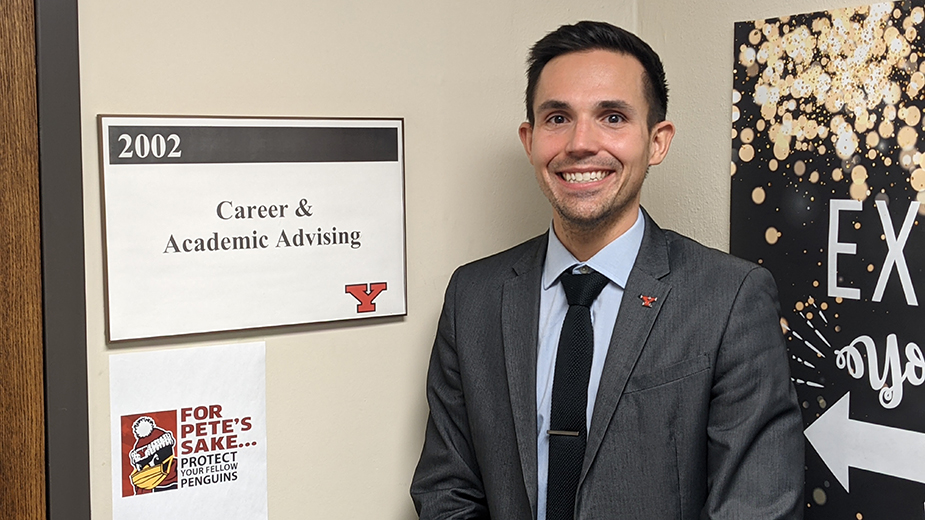YOUNGSTOWN – Handshakes usually signify the completion of an agreement. At Youngstown State University, it’s a virtual way to get the most out of its human investment.
Handshake is an online tool employers can use to post positions and internships, schedule on-campus interviews, request and review résumés, prescreen candidates for interviews and even hold virtual career fairs. Handshake is also used by YSU students and alumni to enhance their job searches.
“When we partner with employers, we want to be sure their process of finding students is going to be as easy as possible,” says Justin Edwards, director of the Office of Career and Academic advising at YSU.
Edwards wants his office to be a liaison between the job-seeking student and employer, making sure each gets the “highest return on their investment of their time.” That means connecting employers with students majoring in the desired field.
It does not cost employers to engage with the online system, but participating in career fairs costs anywhere from $150 for nonprofits to $500 for corporate entities, Edwards says. The Williamson College of Business Administration’s job fair is focused on internships and is a free event, he says.
Every employer that is on Handshake is vetted, Edwards says. Multilevel marketing companies are not allowed and third-party recruiters must disclose who they are representing before their positions are posted.
“It’s to make sure when students use Handshake they have the highest likelihood of a positive interaction,” Edwards says.
Some local entities use other mediums to share employers’ needs with potential workers.
The Youngstown/Warren Regional Chamber has a weekly JobsNow workforce initiative segment on WKBN-27 every Tuesday on the 5 p.m. news broadcast. The local TV station highlights chamber member companies and their job openings, airing nearly 300 segments since 2016, says Sarah Boyarko, the chamber’s chief operating officer and senior vice president of economic development. Some companies, she says, received 60 qualified applicants in one day.
Boyarko emphasizes there is no cost to chamber members to highlight their job vacancies on JobsNow. Interested employers can reach out to Boyarko or visit RegionalChamber.com.
The chamber pairs up with Steward WorkMed to provide no-cost access to five pre-employment 12-panel urine drip drug tests per month. Boyarko says a private foundation funded that process, which was matched by Steward.
Displaced workers in and out of the Mahoning Valley can view these jobs along with the chamber’s relocation guide and customized in-person executive tours, Boyarko says. She adds there are consistent efforts with area school districts to tailor curriculum to better prepare youth for the workforce.
Those opportunities are shared on social media, and on the chamber’s and WKBN’s websites.
Companies, of course, have the ability to find employees on their own, but Boyarko says the chamber makes the process seamless.
“They come to the chamber for a lot of resources that are able to help them save time and money, whether that is a direct resource from the chamber or we’re able to put them in touch with one of our peers,” Boyarko says.
The Mahoning Valley Manufacturers Coalition’s mission is to ensure young people and those pivoting in their careers understand what the available job opportunities are, who is hiring and where to go for training, says MVMC executive director Jessica Borza.
MVMC is a member of the Ohio Manufacturing Workforce Partnership, a statewide initiative to upskill 5,000 Ohioans through work-and-learn apprenticeships. It is funded by a $12 million, four-year U.S. Department of Labor grant. Borza says MVMC has created almost 300 apprenticeship opportunities.
MVMC works closely with career centers in Columbiana, Trumbull and Mahoning counties, as well as Eastern Gateway Community College to make sure their course offerings are matching the employers’ needs, Borza says. She emphasizes the importance of increased enrollment in these learning centers.
“We think it really fast-tracks somebody if they’re really interested in being successful in a manufacturing career,” Borza says.
Because there aren’t enough workers coming through these means, manufacturers have created their own forms of apprenticeships and earn-and-learn programs for existing employees, she adds.
MVMC recently launched a campaign in which manufacturing representatives speak in the community and classrooms to promote job openings, Borza says. MVMC works closely with Ohio Means Jobs, encouraging the coalition’s members to post openings there.
Ohio Means Jobs also offers on-the-job training to manufacturers to help offset costs, Borza says.
MVMC keeps tabs on its members to understand how they are recruiting and training, making sure they understand the grant programs and other opportunities available to them. Borza says manufacturers constantly ask if they are doing everything they can to attract job seekers.
MVMC also has great relationships with Community Action Agencies and Goodwill Industries throughout the Mahoning Valley, and seeks to strengthen connections to high school seniors who do not have a plan after graduation, Borza says.
“We continue to give them advice about best practices in recruiting and so forth,” she says.
EGCC ensures its students are using all of its social media platforms, technology and resources for successful job placement, says Arthur Daly, senior vice president and chief development officer at the school’s downtown Youngstown branch.
EGCC is always reaching out to employers and even has an advisory committee that broadcasts opportunities within those companies, he says.
“We want to make sure students are already in place before they even reach the graduation stage,” says Daly, adding there is no cost to the employer to post positions with EGCC.
Pictured: YSU’s Office of Career & Academic Advising connects employers to students, says Director Justin Edwards.
